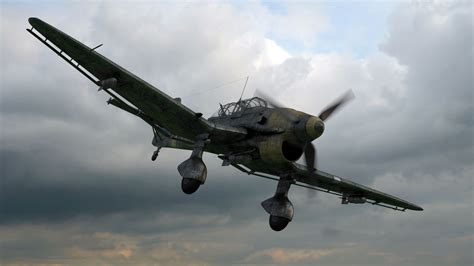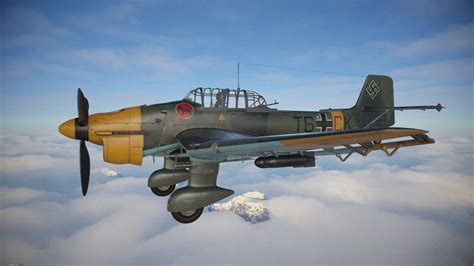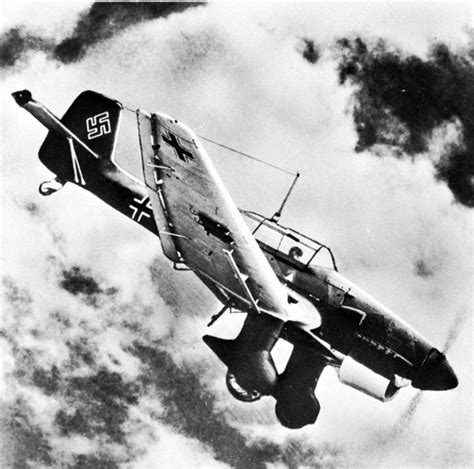Stuka Dive Bomber: Iconic World War II Aircraft

Stuka Dive Bomber: Iconic World War II Aircraft

The Stuka, also known as the Junkers Ju 87, was a German dive bomber and ground-attack aircraft used during World War II. Its distinctive design and screaming sirens made it a feared sight on the battlefield, and its impact on the war was significant. In this article, we’ll delve into the history of the Stuka, its design and capabilities, and its role in World War II.
History of the Stuka

The Stuka was designed in the 1930s by Hermann Pohlmann, an engineer at Junkers, a German aircraft manufacturer. The aircraft was intended to be a dive bomber, capable of delivering precision attacks on enemy targets. The Stuka made its first flight in 1935 and entered service with the German Air Force (Luftwaffe) in 1937.
The Stuka’s design was influenced by the German doctrine of Blitzkrieg, or “lightning war,” which emphasized rapid and decisive attacks on enemy positions. The aircraft was designed to be rugged and reliable, with a strong airframe and a powerful engine. Its distinctive inverted gull wings and fixed undercarriage made it easily recognizable on the battlefield.
Design and Capabilities

The Stuka was powered by a single Junkers Jumo 211 engine, which produced 1,200 horsepower. It had a top speed of around 250 mph and a range of approximately 300 miles. The aircraft was armed with two 7.9mm machine guns and could carry a payload of up to 1,100 pounds of bombs.
One of the Stuka’s most distinctive features was its screaming siren, which was designed to intimidate enemy troops and disrupt their morale. The siren was actually a Jericho Trumpet, a device that produced a loud, piercing noise when the aircraft dove towards its target.
The Stuka was also equipped with a unique dive-braking system, which allowed it to maintain a steep dive angle and achieve high accuracy when delivering its payload. This system consisted of a series of flaps and spoilers that were deployed during the dive, which helped to slow the aircraft’s descent and stabilize its flight path.
Role in World War II

The Stuka played a significant role in World War II, particularly during the early years of the war. Its precision bombing capabilities made it an effective tool for targeting enemy positions, and its ability to operate in close support of ground troops made it a valuable asset for the German military.
The Stuka was used extensively during the Battle of Britain, where it was employed to attack British airfields and aircraft factories. It also saw action during the invasion of Poland, France, and the Soviet Union, where it was used to support ground troops and attack enemy positions.
However, the Stuka’s vulnerability to enemy fighters and anti-aircraft fire made it increasingly obsolete as the war progressed. By 1943, the Stuka had largely been replaced by more modern aircraft, such as the Focke-Wulf Fw 190 and the Messerschmitt Bf 109.
Legacy of the Stuka

Despite its relatively short service life, the Stuka left a lasting legacy on the world of military aviation. Its design and capabilities influenced the development of later aircraft, such as the A-4 Skyhawk and the A-10 Thunderbolt II.
The Stuka also played a significant role in the development of dive-bombing tactics, which were used extensively during World War II and the Korean War. Its screaming siren became an iconic symbol of fear and intimidation, and its rugged design and reliability made it a respected opponent on the battlefield.
Specifications

- Length: 37 feet 6 inches (11.43 meters)
- Wingspan: 45 feet 3 inches (13.79 meters)
- Height: 13 feet 1 inch (4 meters)
- Empty weight: 8,377 pounds (3,800 kilograms)
- Max takeoff weight: 12,000 pounds (5,400 kilograms)
- Powerplant: 1 x Junkers Jumo 211 engine, 1,200 horsepower
- Maximum speed: 250 mph (402 kilometers per hour)
- Range: 300 miles (483 kilometers)
- Service ceiling: 26,900 feet (8,200 meters)
- Rate of climb: 3,200 feet per minute (16.3 meters per second)
📝 Note: The Stuka's performance specifications varied depending on the model and configuration.
Tactical Uses

The Stuka was used in a variety of tactical roles during World War II, including:
- Dive bombing: The Stuka’s primary role was as a dive bomber, where it would attack enemy positions with precision-guided bombs.
- Ground attack: The Stuka was also used to attack enemy ground troops and fortifications, using its machine guns and rockets.
- Reconnaissance: The Stuka was occasionally used for reconnaissance missions, where it would gather intelligence on enemy positions and movements.
Notable Operators

The Stuka was operated by several countries during World War II, including:
- Germany: The Stuka was primarily used by the German Air Force (Luftwaffe).
- Italy: The Italian Air Force (Regia Aeronautica) operated a small number of Stukas.
- Hungary: The Hungarian Air Force (Magyar Királyi Honvéd Légierő) operated a small number of Stukas.
- Romania: The Romanian Air Force (Forțele Aeriene Regale Române) operated a small number of Stukas.
What was the primary role of the Stuka during World War II?

+
The primary role of the Stuka during World War II was as a dive bomber, where it would attack enemy positions with precision-guided bombs.
What was the distinctive feature of the Stuka's design?

+
The Stuka's distinctive feature was its inverted gull wings and fixed undercarriage, which made it easily recognizable on the battlefield.
What was the impact of the Stuka on the development of military aviation?

+
The Stuka's design and capabilities influenced the development of later aircraft, such as the A-4 Skyhawk and the A-10 Thunderbolt II. Its dive-bombing tactics also played a significant role in the development of modern airpower doctrine.
In conclusion, the Stuka was an iconic and influential aircraft of World War II, known for its distinctive design and screaming siren. Its precision bombing capabilities and rugged design made it a valuable asset for the German military, and its legacy can still be seen in modern airpower doctrine.